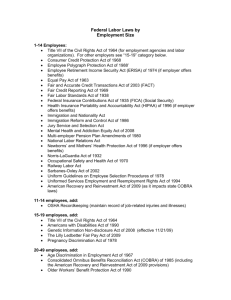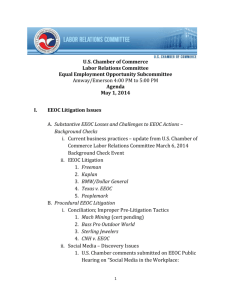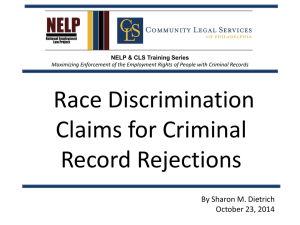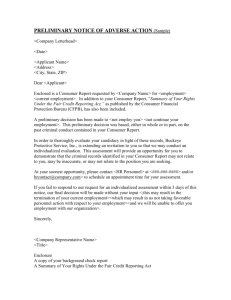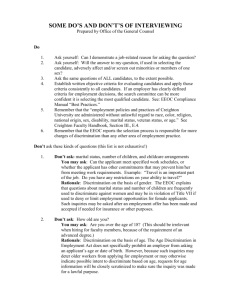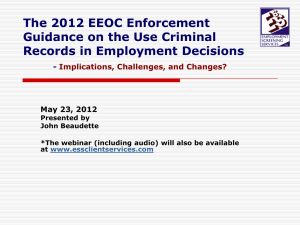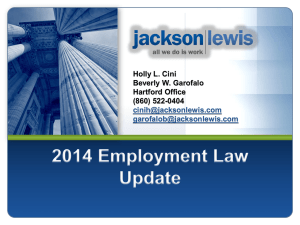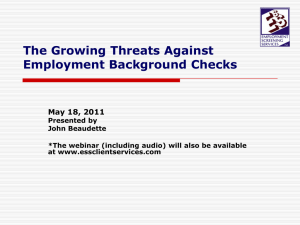PWR PT Presentation - Retail Industry Leaders Association
advertisement
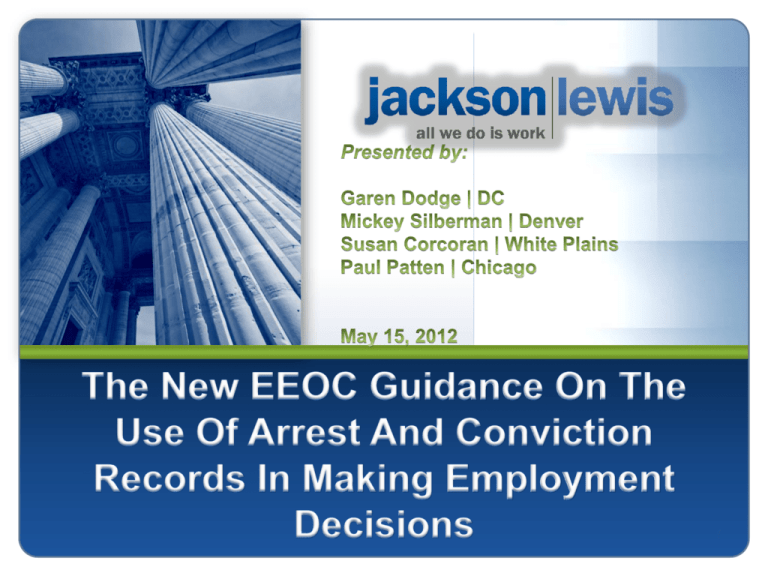
1 Represents management exclusively in every aspect of employment, benefits, labor and immigration law and related litigation Over 700 attorneys in 49 locations nationwide Current caseload of over 5,000 litigations and approximately 300 class actions; over 2,100 litigations brought to the firm in 2010 alone Founding member of L&E Global 2 Ranked in the First Tier nationally in the category of Labor and Employment Litigation, as well as in both Employment Law and Labor Law on behalf of Management in the U.S. News - Best Lawyers® “Best Law Firms” Recommended in U.S. Legal 500 for Labor and Employment Litigation, Labor-Management Relations and Workplace and Employment Counseling Recognized by in-house counsel of Fortune 1000 companies in a survey conducted by BTI Consulting Group as “the single highest-ranked firm clients want by their side in employment battles” 54 Jackson Lewis attorneys were named Leaders in Their Field by Chambers USA for 2011; 60 Jackson Lewis attorneys were named Best Lawyers in America® in the 2012 edition 3 4 Affirmative Action and OFCCP Planning and Counseling Labor, including Preventive Practices Corporate Diversity Counseling Litigation, including Class Actions, Complex Litigation and e-Discovery Disability, Leave and Health Management Employee Benefits, including Complex ERISA Litigation and Executive Compensation Global Immigration Non-Competes and Protection Against Unfair Competition Wage and Hour Compliance Workplace Safety Compliance 5 Alternative Dispute Resolution Collegiate and Professional Sports Industry Group Corporate Governance and Internal Investigations Drug Testing and Substance Abuse Management International Employment Issues Government Relations Management Education, including e-Based Training Privacy, Social Media and Information Management Public Sector Issues Reductions in Force, WARN Act 6 Jackson Lewis represents a wide range of companies in various industries, including: Automotive Hospitality Banking Insurance Construction Manufacturing Education Energy Financial Services Non-Profit Pharmaceuticals Real Estate Retail Government Sports Health Care Transportation 7 GAREN E. DODGE is a Partner in the Washington, D.C. Region office of Jackson Lewis LLP. He is co-Leader of the firm’s Government Relations practice, and coordinator of the firm’s Government Contracts industry group. Mr. Dodge represents clients before Congress and key federal agencies such as the EEOC. In that context, he advised EEOC Commissioners and their staffs on the agency’s criminal background guidance. He submitted comments and provided analysis that helped improve that guidance. After issuance of the guidance, Mr. Dodge provided analysis to the media, including the Daily Labor Report, and has spoken to multiple industry groups to facilitate compliance. Phone: (703) 483-8323 Email: dodgeg@jacksonlewis.com 8 SUSAN M. CORCORAN is a Partner in the White Plains, New York office of Jackson Lewis LLP. She serves as a Firm resource on fair credit reporting act and background check issues, having assisted many employers and consumer reporting agencies in their compliance efforts. Ms. Corcoran has also been involved in providing litigation support and employment defense of background check decisions, particularly given New York has long provided individuals who have been convicted of crimes protections under its Corrections Law. Phone: (914) 514-6104 Email: corcors@jacksonlewis.com 9 PAUL PATTEN is a Partner in Jackson Lewis’s Chicago Office. Mr. Patten frequently represents clients facing Equal Employment Opportunity Commission pattern or practice investigations and subsequent litigation by the EEOC. Earlier in his career, Mr. Patten was a Trial Attorney for the EEOC. Phone: (312) 803-2570 Email: pattenp@jacksonlewis.com 10 MICKEY SILBERMAN is the Chair of the Affirmative Action-OFCCP practice group and is the Managing Partner of the firm’s Denver, Colorado office. Mickey specializes in systemic discrimination, affirmative action, EEO compliance, and diversity. Mickey spends much of his time counseling companies on complex, "real world" issues relating to systemic discrimination, diversity, EEO, and affirmative action compliance. He has helped many national employers develop compliance programs relating to recruitment, applicant tracking, pre-employment testing, background checks, compensation systems, performance assessment, succession planning, etc. He also conducts mock audits to help companies assess their compliance with EEO and affirmative action obligations. Phone: (303) 225-2400 Email: silbermm@jacksonlewis.com 11 On April 25, 2012 the EEOC approved, by a 4-1 vote, an Enforcement Guidance on the Consideration of Arrest and Conviction Records in Employment Decisions under Title VII of the Civil Rights Act of 1964 The Guidance was effective immediately There was no public comment on proposed content The Guidance is 52 pages (although pages 27-52 are endnotes) and give examples of proper and improper employer practices We will reference the examples throughout today’s Program 12 The Guidance replaced a 1987 EEOC Policy Statement regarding Conviction Records; and a 1990 Policy Guidance on the Consideration of Arrest Records 13 Dissenting Commissioner Barker “In summary - I object to the utter lack of transparency in the development of this guidance. I object to the inexcusable way the public has been intentionally shut out of this process. I object to the unnecessary haste at which this document has been pushed through, and I object to the burden it places on business owners.” 14 On the other hand, the Legal Action Center press release states: “LAC and HIRE wholeheartedly support the new guidance, including provisions that: Put employers on notice that categorical exclusions for people with certain convictions may violate [federal law] because of the disparate impact on minorities…. Offer examples of common policies and practices that violate Title VII….” ACLU, NELP and others very pleased 15 The Jackson Lewis Government Relations team worked publicly and privately Met with individual Commissioners and staff Organized a full-day “hearing” at US Chamber Submitted comments and legal analysis Capitol Hill OMB (OIRA) The final Guidance is an improved document EEOC is not finished: credit checks and other “barriers” to employment 16 Employer’s neutral policy may disproportionately impact individuals protected under Title VII (disparate impact) Disparate impact burden-shifting framework: o Plaintiff(s) or EEOC demonstrates the employer’s facially neutral policy has a statistically significant disparate impact on a protected group o Burden shifts to employer to demonstrate the policy is job-related and consistent with business necessity (and consistently applied) o Even if the employer proves business necessity, the plaintiff(s) or EEOC may prevail by showing the employer refused to adopt an alternative practice that would satisfy the employer's legitimate interests without having a disparate impact on a protected class 17 EEOC will seek to make a prima facie disparate impact case through statistical analyses of the employer’s applicant, workforce, and/or third-party background history Therefore, expect the EEOC to request applicant and background check data in its investigations o “The Commission will assess relevant evidence when making a determination of disparate impact, including applicant flow information maintained pursuant to the Uniform Guidelines on Employee Selection Procedures, workforce data, criminal history background check data….” 18 Technology has changed everything -- and EEOC knows it It is easier than ever before to gather detailed applicant and background check data o Applicant flow data maintained in ATS o Background check data maintained by third-party providers Applicant and background check data spanning several years and/or covering multiple locations can be run in a single report. This makes it more difficult for employers to argue it is too burdensome to produce the data EEOC knows “big numbers are bad numbers” – large data sets are more likely to tip over into statistical significance 19 Oftentimes, the Agency will first request more general information about applicant or background check data, including the following: o Fields of information available o Dates of information available o Who maintains the data and how it is stored, etc. WHICH LEADS TO… RFIs for detailed applicant and/or background check databases, which are often: o Nationwide in scope o Span over several years (3-5 years is typical) o Requested of third-party vendors 20 ANALYSIS RATE FOR GROUP ON LEFT RATE FOR GROUP ON 80% STANDARD RIGHT RULE DEVIATION Minority v. Non-Minority 19000/20000 29000/30000 .95 .97 Female v. Male 23500/25000 24500/25000 .94 .98 40+ v. Under 40 9500/10000 .95 38500/40000 .96 0.98 0.96 0.99 9.317 OSR 48000/ 50000 .96 EXP ACT DIF 19200 19000 200 22.822 48000/ 50000 .96 24000 23500 500 5.705 48000/ 50000 .96 9600 9500 100 Once the EEOC or plaintiff(s) makes a prima facie case through statistical evidence, the burden shifts to the employer to demonstrate that the selection procedure was job-related and consistent with business necessity. 21 From the prior example o Job: Customer Service Representatives o Review Period: 3/9/09 - 4/24/12 (3+ years) o Wage Rate: $440 Week ($11/Hour) o Shortfall: 100 (40+ Analysis) Potential Damages: $10 million Systemic background check cases can result in millions of dollars of potential liability 22 Employers should be concerned by the new guidance if they use criminal background checks and: o Use them on a regular basis (“big numbers are bad numbers”) o Solicit and maintain race, gender, age, disability or veteran data on applicants – this applies to government contractors and subcontractors in particular o Applicant and/or background check data is maintained by the company or through a vendor o Have a “one size fits all” criminal background check policy 23 Requires review of practices but in this speaker’s opinion does not restrict employers’ rights to continue to make reasonable employment decisions based on criminal background information This concept is reinforced for multi-state employers for whom an individualized analysis has long been required under state and local laws – such as NYS and NYC 24 Arrests itself – as opposed to underlying conduct – should not be considered in making employment decisions – no significant change – the Guidance respects an employer’s right to make credibility determination Convictions – should be subject to individualized analysis and dialogue as noted above, individualized analysis already required under some state laws such individualized analysis also was suggested – to a lesser extent – in the prior guidance 25 Under Title VII, an employer may justify a practice that results in a disparate impact by demonstrating a business necessity for that practice. An employer can demonstrate business necessity under the 1987 Policy by showing it considered three factors in making its decision: 1. The nature and gravity of the criminal offense(s); 2. The time that has passed since the conviction and/or completion of the sentence; and 3. The nature of the job held or sought. (“Green factors”) In essence, utilization of the factors was a proxy for business necessity and the basis for arguing to EEOC there is no need for a disparate impact analysis. 26 Narrowly Targeted Screens May Satisfy Business Necessity - The Guidance contemplates that an employer may satisfy its Title VII obligations by using an internal policy if it is “narrowly tailored.” The Guidance explains “narrowly tailored” as a “demonstrably tight nexus to the position in question. Title VII thus does not necessarily require individualized assessment in all circumstances.” The Guidance refers to “targeted screens” that are based on the Green factors, i.e., the nature of the crime, the time elapsed and the nature of the job. 27 “Depending on the facts and circumstances, an employer may be able to justify a targeted criminal records screen solely under the Green factors. Such a screen would need to be narrowly tailored to identify criminal conduct with a demonstrably tight nexus to the position in question. Title VII thus does not require individualized assessment in all circumstances. However, the use of individualized assessments can help employers avoid Title VII liability by allowing them to consider more complete information on individual applicants or employees, as part of a policy that is job related and consistent with business necessity.” 28 The guidance does not require pre-validation of disqualification criteria Of course, SUCH A PER SE STANDARD SHOULD BE THE EXCEPTION, NOT THE RULE and as noted the Guidance suggests that individualized analysis accompany such a targeted screen The Guidance does not provide an example of a narrowly targeted screen that would pass muster. However, Commissioner Lipnic previously provided the example of an applicant for a day care center who had been convicted of child molesting Recency also likely would be an issue in determining whether a targeted screen, alone, would suffice 29 Validation Of Criminal Conduct Exclusion – but is there data or analysis about criminal conduct as related to subsequent work performance or behaviors? The EEOC appears doubtful that data exists to allow an employer to conduct such a validation study 30 Targeted Screens Accompanied by Individualized Assessment – THE BEST PRACTICE - the Guidance clearly prefers that a targeted screen be accompanied by notice to the individual under scrutiny and an individualized assessment of the individual and the crime and the position in question. The Guidance lists nine possible topics of consideration in an individualized assessment, all of which generally require a dialogue: 31 Criminal record is inaccurate The facts and circumstances surrounding the offense; The number of offenses for which the individual was convicted; Age at time of conviction or release from prison; Evidence that the individual performed the same type of work, post-conviction, with the same or a different employer, without incidents of criminal conduct; The length and consistency of employment history before and after the offense; 32 Rehabilitation; Employment or character references and other information regarding the individual’s fitness for the particular position; and Whether the individual is bonded. If the individual does not respond to the employer’s inquiries, the employer may make its decision without the information. 33 Federal disqualifier prevails and employers not even required to seek waivers. Examples include: o Child care workers in federal agencies o Bank employees o Port workers State or local disqualifiers do not 34 Suggested implementation of “ban the box” – but likely does not work for every organization. And we continue to encourage the use of broad questions to maximize ability to argue individual omitted or misrepresented information regarding criminal history We differ from EEOC on this issue because we believe judicious use of information is a better alternative than avoiding information to ensure “bad” decisions are not made Suggestion of claims for those discouraged from applying due to employer’s reputation in community 35 The EEOC has taken the position that it can expand any individual charge into a systemic investigation if the charge does not challenge a criminal background practice or even allege hiring discrimination The charge is more likely to be expanded when the EEOC has information that the employer conducts background checks Courts have generally approved of such expansion, particularly if the EEOC stays within Title VII and proper notice of the expansion is provided by the EEOC 36 The EEOC will be looking for evidence that an employer conducts criminal background checks in unrelated charges Avoid erroneously providing criminal background practice and policy information in exhibits to EEOC in unrelated charges If the charge does not address criminal background issues, avoid unnecessarily disclosing the fact that the charging party took and passed a criminal background check, which might be contained in a personnel file 37 EEOC offices that are straightforward will provide official notice Notice will be followed by a broad request for information The EEOC seeks “big numbers” The EEOC perceives inconsistencies, e.g., one particular decision maker or HR representative who mistakenly did not follow the EEOC’s policy or the employer’s stated policy, as evidence of a broader problem 38 Be completely honest with the EEOC (know the facts before making representations) Keep the scope of the response narrow (initially provide data for workforce subgroups (geographic, time, job position)) Utilize statistical expertise to determine the scope of the response Demonstrate compliance with EEOC policies (this is dependent on having policies in place and implemented) 39 Targeted Screens: use different standards for different positions Avoid policies that indicate automatic exclusions, instead, “Acme Corp. believes the following crimes are job related--applicants with these offenses will be subject to individualized assessment” Train HR and decision makers to avoid local decision makers’ instinct to rely on hard and fast rules—such communications jeopardize demonstrating compliance Self-audit to root out inconsistencies, e.g. on-line kick out 40 Document thought process if developing general disqualifications, business purposes, past experience, etc. Consider making criminal inquiry at interview stage— preferred by EEOC and avoids EEOC concern that criminal backgrounds were considered at application stage Disqualifiers mandated by state law: arguably the business necessity defense applies; make sure the crime precisely meets the definition of the state exclusion; to be safe, perform individualized inquiry 41 If settling, use of legal counsel is vitally important Various Title VII defenses and developing court precedent can assist to limit the time and geographic scope of victim class Absolutely crucial to utilize counsel familiar with “statistical cases” so that data can be presented appropriately and relief limited in amount and to proper victim class 42 Also there is the potential for class action suits driven by plaintiffs’ bar Be careful that individualized assessments do not create disparate treatment issues, i.e., hiring Caucasians who “explain away” a criminal record and not hiring minorities who provide similar explanations 43 Not 100% clear but even if courts don’t, significant potential issues with EEOC before judiciary becomes involved Courts sometimes bow to EEOC guidance – Justice Scalia generally defers to EEOC If guidelines rejected, pure Disparate Impact business necessity analysis applies – difficult standard to meet and arguably validation is required Also potential challenges to Guidance based on manner in which EEOC passed it and potential Congress would limit EEOC’s funding to enforce Guidance 44 Periodically conduct a self-audit of the disparate impact of your background check policies o Analyze your data to identify which criminal offenses are causing disparate impact o Consider alternative policies or background criteria that lessen less impact Analyze the data to ensure it is consistently used to disqualify applicants (if not consistently applied, this can be evidence of disparate treatment) Conduct these analyses under the attorney-client privilege 45 Review and refine current policies Limit per se disqualifiers (especially those that apply to all criminal records) and engage in appropriate analysis for any remaining per se disqualifiers Analyze specific jobs and specific crimes if a general matrix is utilized Consider recency Maintain a file explaining the basis for policy refinements Train personnel with hiring responsibilities 46 Be careful of automatic pre-adverse action letters If ratings are used, utilize caveats Engage in individualized analysis and dialogue whenever possible 47 48 THE MATERIAL CONTAINED IN THIS PRESENTATION WAS PREPARED BY THE LAW FIRM OF JACKSON LEWIS LLP FOR THE ATTENDEES’ OWN REFERENCE IN CONNECTION WITH THIS SEMINAR. SINCE THE MATERIAL AND RELATED DISCUSSIONS ARE INFORMATIONAL AND EDUCATIONAL IN NATURE AND REPRESENT THE SPEAKER’S OWN VIEWS, ATTENDEES SHOULD CONSULT WITH COUNSEL BEFORE TAKING ANY ACTIONS AND SHOULD NOT CONSIDER THESE MATERIALS OR RELATED DISCUSSIONS TO BE LEGAL OR OTHER ADVICE. PROFESSIONAL ADVICE SHOULD BE OBTAINED BEFORE ATTEMPTING TO ADDRESS ANY LEGAL SITUATION OR PROBLEM. 49
